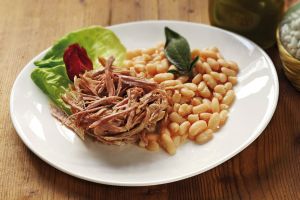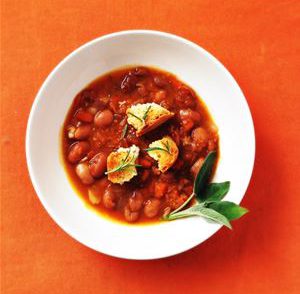Learning Italian can be tricky enough, especially when there are obstacles along the way, such as the Tuscan dialect, the Florentine accent and the frequent use of words with double meanings. Thus, speaking fluent Italian doesn’t mean you are necessarily going to get what you think you want when ordering at a Have you ever wondered why Tonno del Chianti is not listed in the fish section of menus in restaurants and trattorie? We know that Tuscans use the Italian word for ginger when referring to chilli pepper, but pescatarians should be very aware when ordering tonno del Chianti. Just like tuna, it is often served with fagioli sgranati and slices of Tuscan red onion from Certaldo. It looks like tinned tuna and even tastes like tinned tuna. But what many may not know is it’s made from tasty pig parts.
Tonno del Chianti, a dish that has been prepared in Tuscan kitchens for generations, owes its reinvention and name to Dario Cecchini, the world-famous butcher of the Antica Macelleria Cecchini in Panzano in Chianti. The story goes that about 20 years ago an elderly local whose late father was by passion an alchemist and in fact a norcino (pig butcher), came to share his recollections of his father with Cecchini and talk about the way he prepared his pigs into various specialties, one of which was a boned-out leg of pork poached in white wine. Cecchini says he thought long and hard about what he had heard and eventually did some trials in his butchery. What he came up with was tonno del Chianti.
Historically, in home kitchens, contadine toscane would turn some of i lattonzoli, the suckling pigs, that were having trouble latching on to drink their mothers’ milk, into a version of tonno del Chianti. The lattonzoli would be boned out and would be slow-cooked in white wine with such aromatics as alloro e ginepro and then preserved in olive oil. The same thing was done to the scraps of pork off-cuts. In times gone by, it was preserved in terracotta pots, conserved sott’olio and kept in a cool, dark place, which helped preserve the meat for the winter months. Nowadays, it is eaten fresh or preserved in glass jars, and covered in Tuscan extra-virgin olive oil.
Variations of this dish include poaching the pork in a meat or a vegetable stock rather than white wine, or poaching it directly in olive oil. This is very similar to the French dish of pork rillettes, a centuries-old dish of pork poached, shredded and preserved in rendered pig fat.
Here is my version of this Chianti classic, which can be eaten the same day or preserved sott’olio and refrigerated to last for a month.
Buon appetito!

RECIPE Tonno del Chianti
INGREDIENTS
600 grams leg pork or loin
A handful of rock salt
10 juniper berries
3 bay leaves
Cracked black pepper
Extra-virgin olive oil
1.2 litres of white wine
Extra juniper berries and bay leaves
Peppercorns
Extra ingredients for serving:
Fagioli sgranati
Red onion
PREPARATION
Trim and discard any visible sinew and fat from the pork. Cut it into nice, neat pieces about the size of a breast of chicken. Rub with salt, pepper and aromatics. Cover and leave to marinate in the fridge for two nights. Then rinse with cold running water and set aside.
In a heavy-based pan bring the white wine to a boil, adding a further 5 juniper berries, 2 bay leaves and some more cracked pepper. I like to use a wine from the region and prefer an aromatic to prepare this dish, so I use a Chardonnay IGT Toscana from Greve in Chianti. Place the marinated pieces of pork meat into the white wine, turn down to a very low simmer and cover with a lid. Simmer very slowly for at least 5 hours. To test when the pork is ready to become tonno, press with a fork: if it leaves little resistance and begins to break up it is ready. Leaving the lid on, turn off the flame and set aside to cool slowly to room temperature.
Remove the meat from the wine and cooking juices. With two forks, flake into chunks and pack into sterilised glass jars. Fill the jars with extra-virgin olive oil, ensuring all the meat is covered: last season’s extra-virgin olive oil is the best to use as it is not too strong and will not cover the delicacy of this dish. To each, add a couple of juniper berries, peppercorns and one bay leaf per jar, close lids securely and refrigerate for up to one month.
To serve, drain the tonno del Chianti and flake the meat, allowing it to break into its own natural segments. Serve with freshly podded and cooked fagioli sgranati, cracked pepper and some thinly sliced raw red onion. A drizzle of the olive oil from the jar to finish and this is a mouth-watering piatto unico. The fresh acidity of the Tuscan chardonnay used to cook with is a perfect match for this interesting and tender dish.







